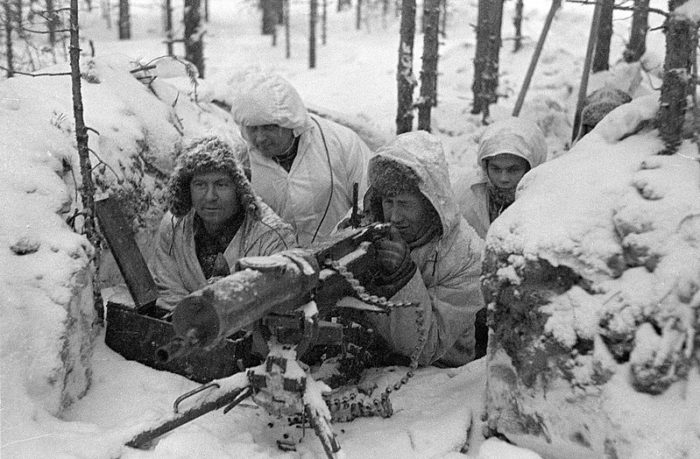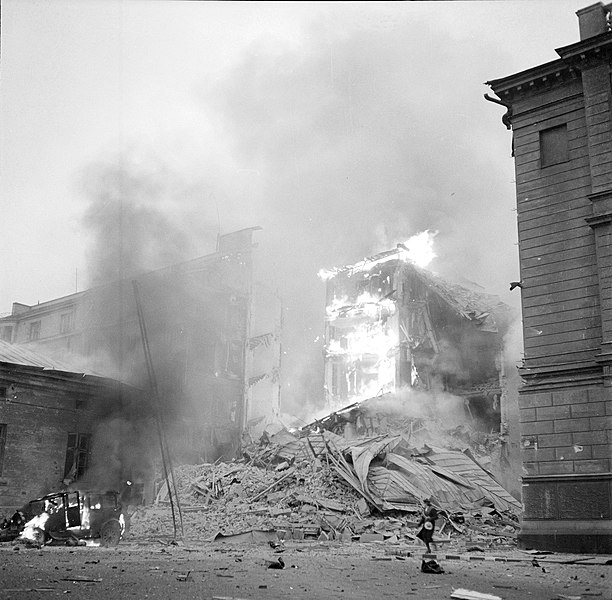WCAG Heading
by Tom Clavin
Oops, Russia did it again. While that country’s historians might not be able to say so out loud, they must be appalled at the invasion of Ukraine and its thus-far unsuccessful outcome. Ignorance or defiance of history has doomed Russia to repeat many of the mistakes of the so-called “Winter War,” with President Vladimir Putin being compared to Josef Stalin for all the wrong reasons. (Okay, there may not be any good ones.) If you have not heard of this war, please read on.

This image is in the public domain via Wikicommons.
The Winter War was a conflict between the Soviet Union and Finland, which began with the latter being invaded in November 1939. Despite superior military strength, especially in tanks and aircraft, the Soviet Union suffered severe losses and initially made little headway. The catalyst was a demand by the Soviet Union that Finland cede substantial border territories, claiming security reasons—primarily the protection of Leningrad, 20 miles from the Finnish border. When Finland refused, the Soviets invaded. Most likely, the Soviet Union had intended to conquer all of Finland, but Finland repelled Soviet attacks for months and inflicted substantial losses on the invaders while temperatures ranged as low as −45 °F, which is almost as cold as Putin’s heart.
Some background: In April 1938, Finnish officials were told that the Soviets did not trust Germany and that war was considered possible between the two countries. The Red Army would not wait passively behind the border but would rather “advance to meet the enemy.” Finland vowed that it was committed to a policy of neutrality and that the country would resist any armed incursion. Negotiations began but the Finnish reception of Soviet entreaties was decidedly cool, as the violent purges by Stalin resulted in a poor opinion of the country. Meanwhile, Finland was attempting to negotiate a military cooperation plan with Sweden.
The Soviet Union and Nazi Germany signed a non-aggression treaty in August 1939. However, it included a secret protocol in which eastern European countries were divided into spheres of interest. Finland fell into the Soviet sphere. On September 1, 1939, Germany began its invasion of Poland and two days later, the United Kingdom and France declared war on Germany. On September 17, the Soviets invaded eastern Poland, Estonia, Latvia, and Lithuania. They were soon forced to accept treaties that allowed the Soviets to establish military bases on their soil. Unlike the three Baltic countries, Finland started a gradual mobilization under the guise of additional “refresher training.”
On October 5, the Soviets invited a Finnish delegation to Moscow for further negotiations. The Soviets demanded that the border between the USSR and Finland be moved westward and that Finland destroy all existing fortifications on the Karelian Isthmus. They also demanded the cession of islands in the Gulf of Finland and the Finns would also have to lease the Hanko Peninsula for 30 years and to permit the Soviets to establish a military base there. The Finns said no, thanks anyway.
On November 26, an incident was reported near the Soviet village of Mainila, near the border with Finland. A Soviet border guard post had been shelled by an unknown party resulting, according to Soviet reports, in the deaths of four and injuries of nine border guards. Research conducted by several Finnish and Russian historians later concluded that the shelling was a “false flag” operation. Coincidentally, Soviet war games held in March 1938 and 1939 had been based on a scenario in which border incidents taking place at the village of Mainila would spark a war. Finland denied responsibility for the attack and called for a joint Finnish–Soviet commission to examine the incident. In turn, the Soviet Union claimed that the Finnish response was hostile, renounced the non-aggression pact, and severed diplomatic relations with Finland.
On November 30, Soviet forces invaded Finland with 21 divisions, totaling 450,000 men, and bombed Helsinki, killing about 100 citizens and destroying more than 50 buildings. In response to international criticism, Soviet Foreign Minister Vyacheslav Molotov stated that the Soviet Air Force was not bombing Finnish cities but rather dropping humanitarian aid to the starving Finnish population; they were sarcastically dubbed “Molotov bread baskets” by Finns. The League of Nations expelled the Soviet Union on December 14 and exhorted its members to aid Finland.
As a harbinger of what we might see in Ukraine, a few days after the invasion the Soviet Union created the Finnish Democratic Republic, a puppet government (after the war, this government was reabsorbed into the Soviet Union). From the very outset of the war, working-class Finns stood behind the legitimate government in Helsinki. Finnish national unity against the Soviet invasion was later called the “spirit of the Winter War.”

Image by Military Museum on the Finna service hosted by the Finnish Ministry of Education and Culture. This file is licensed under the Creative Commons Attribution 4.0 International license.
The array of Finnish defense structures that during the war began to be called the Mannerheim Line was located on the Karelian Isthmus approximately 30 to 40 miles from the Soviet border. The Red Army soldiers on the Isthmus numbered 250,000, facing 130,000 Finns. The Finnish command deployed a defense of about 21,000 men in the area in front of the Mannerheim Line to delay and damage the Red Army before it reached the line. The toughest challenge for the Finnish soldiers was Soviet tanks because the Finns had few anti-tank weapons and insufficient training. But the Finns learned that at close range, tanks could be dealt with in many ways; for example, logs and crowbars jammed into the “bogie wheels” (no, not named after Humphrey Bogart) would often immobilize a tank. Soon, Finns fielded a better ad hoc weapon which would become known as the “Molotov cocktail”—a glass bottle filled with flammable liquids with a simple hand-lit fuse. Molotov cocktails were eventually mass-produced by a Finnish alcoholic-beverage corporation and bundled with matches with which to light them. Eighty Soviet tanks were destroyed in the border zone engagements.
More interested readers can look up the details of the battles and other events of the Winter War. Let’s skip to the part in early 1940 when the Soviet invasion gets bogged down at several points because of staunch Finnish resistance and the logistics of the invaders being supplied with food and fuel, especially during difficult weather conditions. Also, the Finns were able to isolate smaller portions of numerically superior Soviet forces and attack them from all sides.
Morale became a serious issue for the invaders. Many of the encircled Soviet troops were freezing and starving and endured poor sanitary conditions. The Soviet soldier had no choice—if he refused to fight, he would be shot; if he tried to sneak through the forest, he would freeze to death. And surrender was no option because Soviet propaganda had told him how the Finns would torture prisoners to death. However, the Finns were mostly too weak to fully exploit their success. Some of the pockets of encircled Soviet soldiers held out for weeks and even months, binding a huge number of Finnish forces.
On March 6, 1940, after a few setbacks, the Finns proposed a truce, but the Soviets, wanting to keep the pressure on, declined. While a Finnish peace delegation traveled to Moscow anyway, their military situation on the Karelian Isthmus was dire, as troops were experiencing heavy casualties. Artillery ammunition was exhausted and weapons were wearing out. The Finnish government, realizing that the hoped-for Franco-British military expedition would not arrive in time, as Norway and Sweden had not given the Allies right of passage, had little choice but to accept the existing Soviet terms. When the president of Finland, Kyosti Kallio, signed the document, he exclaimed, “Let the hand wither that signs this monstrous treaty!”
In the end, the Soviets had managed to gain 9 percent of Finnish territory. In exchange, their losses were heavy, and the country’s international reputation suffered. Finland retained its sovereignty and enhanced its international reputation. The poor performance of the Red Army encouraged German Chancellor Adolf Hitler to believe that an attack on the Soviet Union would be successful. As we now know, he was eventually proved wrong but at the cost of millions of lives.
Glory to Ukraine. And as the great historian Yogi Berra once said, for the Russians “it’s déjà vu all over again.”
Originally published on Tom Clavin’s The Overlook.
Tom Clavin is a #1 New York Times bestselling author and has worked as a newspaper editor, magazine writer, TV and radio commentator, and a reporter for The New York Times. He has received awards from the Society of Professional Journalists, Marine Corps Heritage Foundation, and National Newspaper Association. His books include the bestselling Frontier Lawmen trilogy—Wild Bill, Dodge City, and Tombstone—and Blood and Treasure with Bob Drury. He lives in Sag Harbor, NY.


